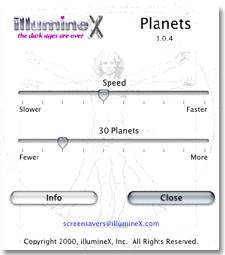This screen saver simulates the motion of a collection of "planets". Each is attracted to the others by gravity. When planets collide, they join together to form a larger planet. When a planet gets too large, it will explode, producing many smaller planets. This cycle continues onward, as the planets follow their paths through space...
The Planets screensaver module is based on a module written by Kurt Werle for NEXTSTEP's BackSpace screen saver program.
This module still uses the physics simulation code from the original module, but the actual drawing code itself is all new and radically different. We have given the module new options and features, tuned it to look great on Mac OS X, and based the new Objective-C code upon Apple's Quartz and Cocoa technologies.

In this screen saver there are two basic parameters available to you, "Speed" and "Planets".
"Speed" controls the screen saver's attempted frame rate and ranges from 10 to 100 frames per second. Of course, the actual frame rate achieved will depend upon your computer's ability to keep up. As such, you may not be able to get a full 100 frames per second even if you request it. Setting the speed lower will use less CPU, which may be important if you are running background processes such as SETI@home or a web server. The default setting is 30 frames per second.
"Planets" controls the maximum number of planets that can be on the screen at a time. (There may be fewer if planets have merged.) This value ranges from 10 to 100 planets. The default is 30 planets.
